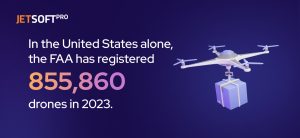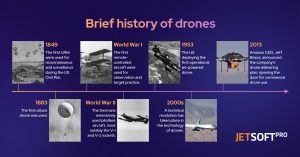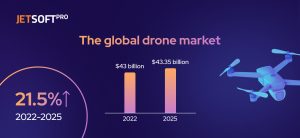Welcome to the Future!
Drones were the stuff of science fiction not so long ago, but today we take them for granted. For example, the FAA registered 855,860 drones in the United States alone in 2023.

Let’s take a closer look at the world of drones and their software to understand what the future holds for them.
The History of Drones: From a Tool of War in World War II to the Mainstream.
The history of drones dates back centuries, with the use of unmanned aerial vehicles (UAVs) first reported in 1849. The first UAVs were used for reconnaissance and surveillance during the US Civil War, with the first attack drone used in 1883. In World War I, the first remote-controlled aircraft were used for observation and target practice.
In World War II, the Germans extensively used pilotless aircraft, most notably the V-1 and V-2 rockets. During the Cold War, the US and Soviet Union developed increasingly sophisticated UAVs, with the US deploying the first operational jet-powered drone in 1953.

The 21st century has seen a technological revolution in drone technology. Drones can now fly for hours on end, carrying out reconnaissance, surveillance, and even attack missions. Military drones are also used for intelligence gathering and reconnaissance, delivering weapons, and supporting ground forces.
Civilian drones have become more popular in recent years, with various applications from photography to surveying, journalism, and package delivery.
The development of small, affordable consumer drones has revolutionized the drone industry, allowing anyone to explore the skies above.
Several Examples of the Use of Drones Software in Modern Society:
- Drones can be used to capture stunning footage of landscapes because they provide an unprecedented level of control and access to unique angles.
- Drones could deliver packages quickly and efficiently, for example, medical supplies to remote villages. Back in 2013, Amazon Ceo, Jeff Bezos, announced the company’s drone delivery plan, opening the door for commercial drone use.
- Drones allow farmers to track growth quickly and identify potential problems in the agricultural industry. This helps to reduce costs and increase efficiency.
- Drones can be used for surveillance and search-and-rescue operations. They can monitor large areas and be deployed quickly in a disaster.
- Drones can help to inspect infrastructure, such as bridges and buildings. By flying drones around these structures, engineers and architects can better understand their condition and spot any potential issues.
- Drones are also being used for more creative purposes, such as drone racing or drone light shows.
Read our success story about the Drone Emulation Platform.
This is only part of the possibilities for using drones and their software in modern society. You can write to us to discuss more opportunities for drone software development.
The Bright Future of Drones: What Might Stand In The Way.
The drone industry has been on the rise for the past several years. According to Skykam Technical Inspections, the global drone market is worth $43 billion as of 2022 and is expected to reach $43.35 billion by 2025, growing at a CAGR of 21.5%.

But there are many obstacles that could hinder the development of drones and their software.
The most significant challenge is the lack of clear regulations surrounding the use of drones, both regarding their airspace use and the commercial applications they can be used for.
The other obstacles drones may encounter:
- Public acceptance of drones is relatively low because privacy concerns remain a significant issue.
- Technical challenges such as battery life, communications limitations, and the cost of research and development.
- The lack of skilled personnel that can develop and competently control drones.
- The lack of a cohesive regulatory framework.
Can Drones Disrupt the Future?
While drones have the potential to be used for a variety of beneficial purposes, their use may also lead to negative consequences.
It is essential to find the way how to turn the following potential issues into business opportunities:
- Drones could be used to monitor people.
Drones could be used to spy on people or to collect information about them without their permission, which can lead to potential security risks.
2. Drones could be used as a tool of warfare.
Drones could deliver weapons or explosives. Additionally, drones could be programmed to carry out acts of terrorism, which could lead to destruction and loss of life.
3. The increased use of drones could lead to increased noise pollution.
Drones that operate in populated areas could be noisy, which could cause a disturbance to individuals and animals. This noise pollution could also lead to increased stress levels and health problems.
4. Drones could cause job losses.
Some jobs, such as those related to air transportation, could be replaced by drones, leading to a decrease in employment opportunities.
Drones are emerging today in every sector of the economy, and definitely, the drone industry will develop and improve yearly. Therefore, it is necessary to attract innovative software for drones now to be competitive in the future.
As drone experts, JetSoftPro can provide you with a complete 360° drone solution to improve your business efficiency. Write to us, and we will consult you for free: contactus@jetsoftpro.com.

